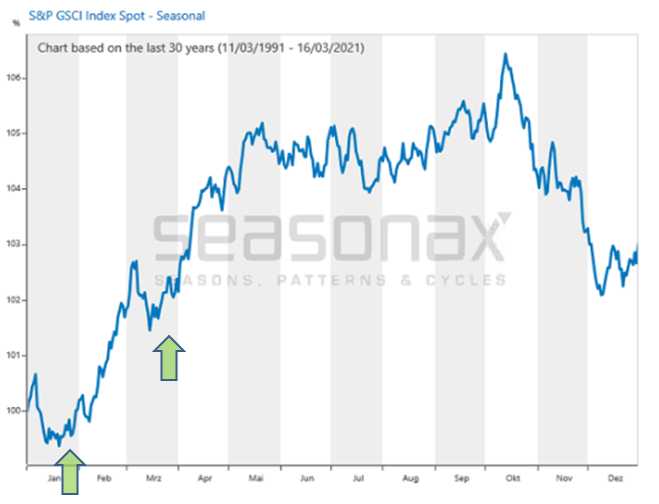Dear Investor,
Over the past several months there have been spectacular rallies in numerous commodities, from copper to crude oil to soybeans.
In light of this many investors are wondering how they can optimally exploit the striking seasonal trends in commodities.
However, in contrast to the seasonality of stocks there are three important points one has to be aware of in connection with the seasonality of commodities. I would like to present these to you today.
The seasonal pattern of the S&P GSCI Spot Commodity Index
The S&P GSCI Spot Commodity Index is one of the oldest commodity indexes. Its history dates back to the beginning of 1970. The S&P GSCI Spot Commodity Index approximates spot market trends by tracking the prices of nearby futures contracts.
The seasonal chart shows the annual seasonal pattern at a glance
Let us take a look at the seasonal chart of the S&P GSCI Spot Commodity Index. In contrast to a standard price chart, the seasonal chart below depicts the average price pattern of the S&P GSCI Spot Commodity Index in the course of a calendar year. To this end, price returns have been averaged over a span totaling 30 years.
The horizontal axis shows the time of year, while on the vertical axis the seasonal chart depicts price information (indexed). This seasonal chart therefore provides us with an illustration of the typical seasonal pattern of the entire commodity market at a glance.

S&P GSCI Spot Index, seasonal pattern over the past 30 years
There is a good entry point in the second half of March. Source: Seasonax
As this indicates, there are good seasonal entry points for the commodities in the S&P GSCI Spot Index at the end of January and then again in mid-March.
Three Tips for Optimizing Seasonal Commodity Investments
However, investing in commodities differs from investing in stocks. One can e.g. not simply buy soybeans and put them into one’s portfolio or store them in the garage. One requires a vehicle such as an ETC, a commodity ETN or a commodity certificate. Investing in commodities is associated with several effects in this context. One therefore has to keep the following three points in mind when conducting a seasonal analysis of commodity investments:
1. Index weightings: Commodity indexes often differ quite significantly from each other in terms of index components. Crude oil (WTI and Brent) e.g. has a weighting of around 40% in the S&P GSCI Index. By contrast, in other indexes such as the Bloomberg Commodity Index or the Refinitiv / CRB / Thomson Reuters Core Commodity Index the weighting of crude oil is markedly lower. Choose the index instrument (ETC, commodity ETN, commodity certificate, etc.) for your seasonal commodity allocation that comes closest to what you envisage with respect to index components.
2. Index types: If you decide to invest in a product emulating a commodity index (ETC, commodity ETN, commodity certificates, etc.), you should use either this product for the seasonal analysis or the index that comes closest to it (usually called “ER” or “TR”, but not “spot”). This is because investable products in consumable commodities ultimately track futures prices rather than spot prices (background: in contrast to financial assets such as stocks, the futures prices of consumable commodities can deviate to a much greater extent from spot prices).
3. Rollover rules: individual commodities offer more investment opportunities than commodity indexes. In the case of consumable commodities such as copper, crude oil or soybeans, investments are usually made through futures contracts or products that track futures prices (via the associated ETCs, commodity ETNs, commodity certificates, etc.). However, since futures have finite terms to maturity, invested funds have to be moved into the next front month future at the end of the term (“rollover”; for products that track futures prices such as ETCs, commodity ETNs or commodity certificates, the issuer is taking care of this). Depending on the rollover rule, different patterns result. Therefore, the seasonal patterns of identical commodities may actually look different. However, as a Seasonax user you do not have to concern yourself with the details of rollover rules: the search function of Seasonax automatically suggests the first instrument with a rollover rule that emulates a real investment.
Take advantage of seasonal patterns in commodities!
I myself am convinced of seasonal patterns in commodities. There are sound reasons for seasonality in commodities. My backtracking shows that there are numerous recurring patterns in commodity futures as well. In addition, individual commodities have quite different seasonal patterns, which increases diversification. All of this makes seasonal investing in commodities prospectively very promising.
With the help of a bullish underlying trend, particularly large profits could actually become possible with seasonal investment strategies in commodities in coming months and years. Therefore, take advantage of the seasonal commodity charts and the analysis functions for commodities that can be found in Seasonax!
I also recommend this article about how to trade commodities optimally with Seasonax.
Yours sincerely,
Dimitri Speck
Founder and Head Analyst of Seasonax

